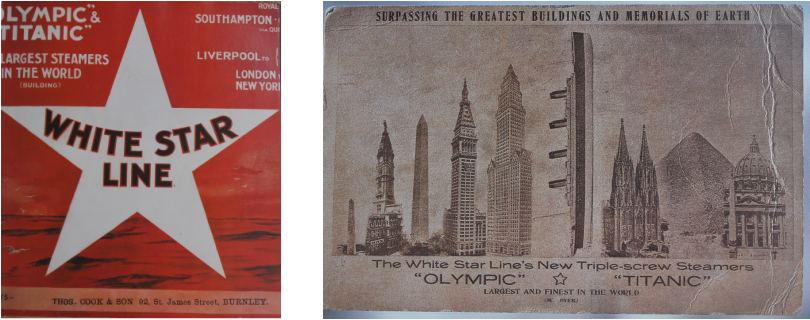The White star line
The White Star Line was started in 1850s and mostly sailed from England to Australia taking prospectors in search of gold. In 1871 White Star moved to the North Atlantic and began taking passengers over on the Oceanic (Stevenson, 1998). White Star soon set new standards for steamship ocean liners in comfort, design and speed. In the 1890's White Star Line was just one of the shipping firms that were fighting for the North Atlantic run. There was an increase in the competition, but British lines, White Start Line and Cunard ruled the waters (Wels, 1997).
In 1907, White Star Line's chairman, J. Bruce Ismay and Lord William James Pirrie, chairman of Harland and Wolff shipbuilding firm, met for dinner and discussed their future. The two of them came up with a plan to build three of the largest sister ships ever to be constructed. Those three ships would be the largest moving objects ever made by man. They would be named Olympic, Titanic and Britannica (Wels, 1997).
In 1907, White Star Line's chairman, J. Bruce Ismay and Lord William James Pirrie, chairman of Harland and Wolff shipbuilding firm, met for dinner and discussed their future. The two of them came up with a plan to build three of the largest sister ships ever to be constructed. Those three ships would be the largest moving objects ever made by man. They would be named Olympic, Titanic and Britannica (Wels, 1997).

The first picture is an ad that could be found advertising the White Star Line (McMillan & Lehrer, pg 7). The second is a postcard (McMillan & Lehrer, pg 99).
The "unsinkable" ship

The sister ships, Olympia and Titanic, were the newest line of ocean liners. They surpassed all the ships that had been constructed before them. They were to be the largest man made moving objects ever to be built, and they exceeded liners before them. The Titanic was larger than her older sister, the Olympia, but only by about 1,000 tons. White Star Line wanted the Titanic to be everything the Olympia was and more. The construction of the Titanic began in 1907 in Belfast (Wels, 1997).
The RMS (Royal Mail Ship) Titanic was a mail ship that also carried passengers, cargo and live stock across the Atlantic Ocean. The Titanic carried 900 tons of baggage and first-class freight- everything from steamer trunks to motor cars to lace bound for New York fashion houses (McMillan & Lehrer).
The Titanic was the one of the most luxurious ships when compared to the other liners that sailed during the nineteenth century. Its first class dining room, which was filled with 127,000 pieces of tableware, was the largest room afloat. There was an elegant a la carte restaurant, which allowed the passengers to plan individual parties. Their exquisite tables were set with silver and gilded Spode china and an orchestra was there to play for the passengers as they dined in style (McMillan & Lehrer, 1997).
The RMS (Royal Mail Ship) Titanic was a mail ship that also carried passengers, cargo and live stock across the Atlantic Ocean. The Titanic carried 900 tons of baggage and first-class freight- everything from steamer trunks to motor cars to lace bound for New York fashion houses (McMillan & Lehrer).
The Titanic was the one of the most luxurious ships when compared to the other liners that sailed during the nineteenth century. Its first class dining room, which was filled with 127,000 pieces of tableware, was the largest room afloat. There was an elegant a la carte restaurant, which allowed the passengers to plan individual parties. Their exquisite tables were set with silver and gilded Spode china and an orchestra was there to play for the passengers as they dined in style (McMillan & Lehrer, 1997).
Titanic Statistis
Length: 882 ft 6 in
Height (waterline to boat deck): 60ft 6in.
Gross Weight: 46,328
Cruising Speed: 23-24 knots
Propulsion: Two 990-ton triple-expansion steam engines and a
420-ton steam turbine enginegenerating a combined 46,000
horsepower
Power: Twenty-nine coal-fired 15-foot-high boilers, each
weighing nearly 100 tons
Decks: 9 steal;
16 watertight compartments with electrically operated doors
(McMillan & Lehrer, pg 15)
Height (waterline to boat deck): 60ft 6in.
Gross Weight: 46,328
Cruising Speed: 23-24 knots
Propulsion: Two 990-ton triple-expansion steam engines and a
420-ton steam turbine enginegenerating a combined 46,000
horsepower
Power: Twenty-nine coal-fired 15-foot-high boilers, each
weighing nearly 100 tons
Decks: 9 steal;
16 watertight compartments with electrically operated doors
(McMillan & Lehrer, pg 15)

